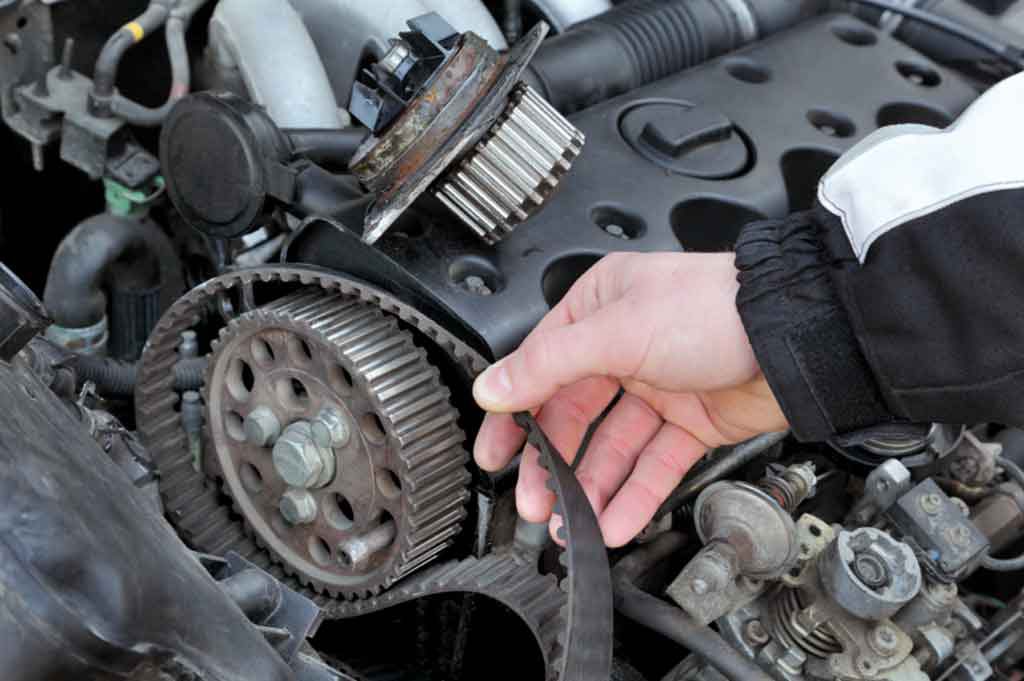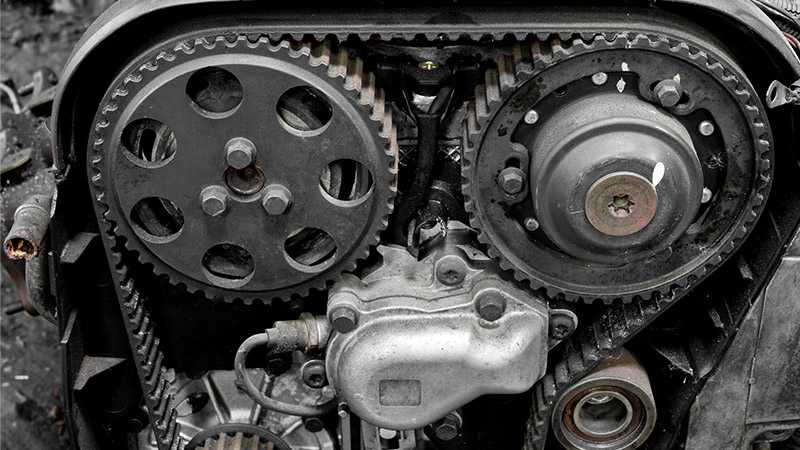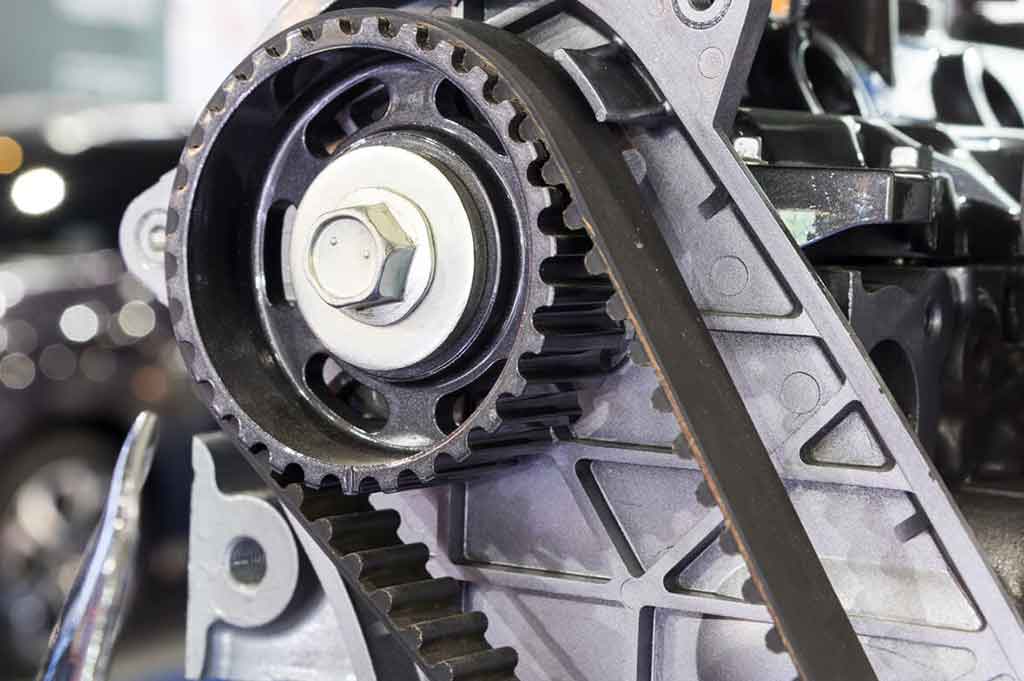There is a part of the car that you may not pay attention to but can ruin your car if it is broken. It is the timing belt. There are a lot of old car models that use timing belts meanwhile new car models use timing chains. Let’s find out what happens when a timing belt breaks!
Contents
What Is Timing Belt
Before going to know what happens when a timing belt breaks, let’s find out what is timing belt.
According to Wikipedia, a timing belt or timing chain is part of an internal combustion engine that synchronizes the rotation of the crankshaft and the camshaft(s) so that the engine’s valves open and close at the proper times during each cylinder’s intake and exhaust strokes. In an interference engine, the timing belt or chain is also critical to preventing the piston from striking the valves. A timing belt is usually a toothed belt—a drive belt with teeth on the inside surface.

To work properly, a timing belt needs to be under certain tension that is controlled by a timing belt tensioner. The belt was for many years made of very tough rubber – especially in most older engines from the early 1990s. But new car models use timing chains instead of timing belts.
Does Your Car Have a Timing Belt?
As we mentioned above, if you have an old car, maybe before the 90s and below, definitely, your car has a timing belt as a rubber. Some new car manufacturers still use timing belts in their engine designs. Besides, new car models have switched to metal timing chains that in theory will last for long. You can Google to check if your car has a timing belt or not. You need to maintain the timing belt by schedule to avoid serious damage to your car.
What Happens When A Timing Belt Breaks?
You already know what a timing belt is and learn how to check if your car has a timing belt or not. Now, let’s dig into what happens when a timing belt breaks.
If the timing belt snaps, two scenarios will depend on the type of engine timing configuration employed.
If your car is an interference engine, it needs the timing belt to prevent the valves and pistons inside your engine from smashing into each other at high speed. So when the timing belt failure while driving, it leads to the result in the respective parts being smashed to pieces. It really damages way beyond the individual components involved such as the broken or bent valves, damaged pistons or even the cylinder head or block.
If your car is a non-interference engine, what happens if my timing belt breaks while driving? Because your car is a non-interference engine, so the pistons and the valves are housed separately. Therefore, a timing belt broke while driving will not cause such damage to them. What you need is to bring your car to the garage and the repairmen will do the rest. They will replace a new timing belt for your car.
When the cracked timing belt is replaced, it is important to set the timing properly. The camshaft and other components should be synchronized with a crankshaft that must be aligned in a certain way before the timing belt is installed. Keep in mind that improperly set timing will cause a variety of problems like lack of power, vibration, misfiring…
>> More Japan-used car types are here, click for more information <<
When Should You Change The Timing Belt?
Each type of timing belt has its lifetime and it is difficult to tell when is the time to replace the new timing belt. But in general, it is recommended that you should change the timing belt every 60.000 miles or about 5 years of driving whichever comes first. The delay in replacing the timing belt could lead to the serious results as we mentioned above.

So when you buy an old car, remember to check the mileage of the car. It will give you basic knowledge about everything, including the timing belt. You also can check with the manufacturer’s recommended intervals for the timing belt changes in your car’s manual. You can check it on the website of the manufacturer since there is no information on the manual book.
Checking your car frequently will help you to handle the information about the condition of your car. If the number of the mileage has not reached 60.000 miles or your car has not been over 5 years, then everything is okay. If yes, replace the new timing belt immediately.
How Much Does It Cost To Replace The Timing Belt?
You now already know what happens when a time belt breaks and how long the timing belt lasts. Now let’s find out how much you need to pay for replacing a new timing belt. Again, it depends on the car maker. Some manufacturers have the cheaper timing belt but for some manufacturers instead, the cost of replacing them is higher. In general, the cost varies from $200 to $750. It is usually to see that the mechanic recommends you also replace the water pump or tensioner, seal idlers… along with a timing belt which will cost more. So dealing with the repairmen beforehand will help you handle the cost of replacing the new timing belt.
See more :
- Want to Know the Exact Duration to Change the Timing Belt? Find Here
- Driving Belt vs Timing Belt- Which is Better?
How To Replace A Broken Timing Belt
So what happens when a timing belt breaks is really serious that we have to take action. By replacing the old timing belt, you can prevent bad things from coming. Let’s learn how to replace a bad-timing belt.
1. Get appropriate equipment
Proper accessories and tools are vital to replace the broken timing belt accurately. Equipment like hydraulic jacks, ratchets, sockets, stands, and screwdrivers is important to the highest degree. Opting for the world-class timing belt would be the ultimate choice to keep the engine running for long. Replacing it after a scheduled time will assist to enjoy the longest of rides.
2. Lift the car and loosen the front tires
Take specific work from the hydraulic jack and loosen the front wheels. Make some space to come across the full components underneath the car engine. This is one of the main parts to work on.
3. Remove the crankshaft and belt
The main shaft is present at the bottom of the engine. And, it is imperative to remove the pulley before replacing the belt. Specific equipment is required to install the new belt. Removing the accessory belt and pulley will take you close to the appropriate removable part. Timing belt failure while driving generally happens in aged vehicles. The professional maintenance tips would assist in safe driving.
4. Remove covers & place new belt
Once you are done with removing part of the belts and all. Try to remove the covers to replace the broken belt with a new one. The new belt will have the same marks as that on the engine cranks. Place the belt accordingly and unite the engine again.
Check out the video below to learn how to replace a broken timing belt!
Sum Up
In general, your car may have a timing belt if it is an old model or a timing chain if it is a new model. And what happens when a timing belt breaks can ruin your car if your car has an interference engine. In case you have a noninterference car, a broken timing belt will not cause serious damage to your car. You can check on the website of your car’s manufacturer to know if your car has a timing belt or timing chain. It is said that you should change the timing belt every 5 years or 60.000 miles whatever comes first.




When I was you, I remember that the timing belt was made of a metal chain but nowadays it is made of rubber. Why? What are the advantages and disadvantages of the rubber belt over the metal one. Or are they different because it was called timing chain and the new one timing belt?
Hi, Azuma. I have a 1969 Austin Mini Estate powered by a 1998 Integra Type R JDM B18C. Why is this such a great engine? Mine was imported from Japan with the standard miles on it. It was not rebuilt, just given new performance Gates timing belt, tuned up and put into the Mini. I’d call this engine as iconic as Chevy’s small block V8. Just giving my 2 yen worth😁
I’ve driven t like hell for the past 9 years–no problems whatsoever! Hard launches, daily driven with A/C on in Texas 100 degree heat, and no heat up. Love to hear Mr. VTEC wail when I get on it.